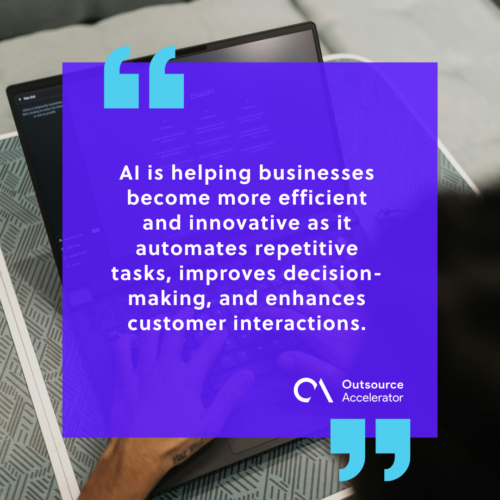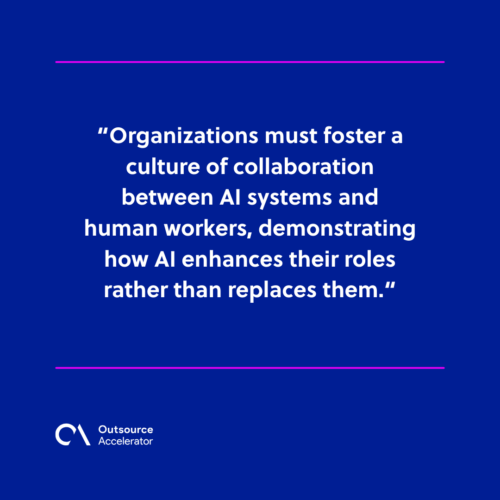Breaking down the 8 biggest AI adoption barriers to success

Artificial intelligence (AI) is transforming business operations as it offers unprecedented opportunities for efficiency and innovation.
Recent data from Statista indicates that 72% of global companies have integrated AI into at least one business function, a significant increase from 55% the previous year. This surge in adoption spans various industries, with sectors like fintech, software, and banking leading the way.
As AI technologies evolve, businesses are taking full advantage of them to streamline processes and deliver superior customer experiences. However, rapid AI adoption also presents major challenges.
Addressing these issues is crucial for organizations aiming to capitalize on AI’s transformative potential fully.
Examples of AI adoption in business processes
Artificial intelligence is becoming a vital part of business operations, reshaping how companies function across industries. AI is helping businesses become more efficient and innovative as it automates repetitive tasks, improves decision-making, and enhances customer interactions.

Here are a few prominent examples of AI adoption in business processes:
Customer service and support
AI-powered chatbots and virtual assistants are now commonly used in customer service. These tools provide instant support, handle common inquiries, and resolve simple issues without human intervention.
Companies like Sephora and H&M use AI chatbots to improve customer engagement and reduce wait times, resulting in better customer satisfaction and more efficient operations.
Supply chain management
AI is also altering supply chains by improving forecasting and inventory management. Companies like Amazon and Walmart utilize AI-driven predictive analytics to forecast demand and optimize their inventory levels.
This helps cut down on wasted resources, saves money, and makes sure customers can get what they want, when they want it.
Marketing and personalization
Businesses are leveraging AI for targeted marketing campaigns and personalized recommendations. Netflix and Spotify use AI algorithms to analyze user behavior and offer tailored content suggestions.
Similarly, e-commerce platforms like Amazon personalize shopping experiences, offering product recommendations based on customers’ past purchases and browsing history.
Fraud detection and risk management
Financial institutions like banks are using AI to detect fraudulent transactions in real-time. Machine learning models can analyze vast amounts of data and identify patterns that indicate potential fraud, helping companies reduce financial risks and enhance security.
These examples highlight the vast potential of AI in transforming business processes and driving growth across various industries.
8 AI adoption roadblocks and how to overcome them
Despite artificial intelligence’s great benefits, many organizations face significant challenges when trying to implement AI successfully. Yes, these roadblocks can hinder progress, but with the right strategies, they can be overcome.
Despite high enthusiasm, a recent Hubstaff report, ‘The AI Productivity Shift,’ reveals a significant gap: 85% of professionals use AI, but it accounts for merely 4% of their total work time, indicating shallow integration.
Here are eight common AI adoption roadblocks and how to address them:
1. Lack of skilled talent
One of the biggest challenges is the shortage of skilled AI professionals. The demand for data scientists, machine learning engineers, and AI specialists often exceeds supply.
To overcome this, companies can invest in training existing employees and use AI tools that require less technical expertise for basic implementation. Another option is to offshore to leading AI solution providers.
2. Data quality and availability
AI models rely heavily on high-quality, structured data. However, many businesses struggle with poor or incomplete data.
The solution lies in improving data collection methods, integrating data from various sources, and investing in data cleaning technologies. It’s also essential to establish a strong data governance framework.
3. Cost of implementation
AI systems can be expensive to implement, particularly for smaller companies. Businesses can address this by implementing AI in stages, beginning with cost-effective solutions that can grow with their needs.
Cloud-based AI solutions are an excellent option since they reduce the upfront cost of infrastructure.
4. Resistance to change
Resistance to AI can come from employees’ concerns about losing their jobs or not fully understanding the technology. Organizations must foster a culture of collaboration between AI systems and human workers, demonstrating how AI enhances their roles rather than replaces them.
Offering training and clear communication about the benefits of AI can help ease these concerns.

5. Integration with existing systems
Connecting AI with older computer systems can be tricky and take a lot of time. Companies should take a phased approach to integration.
Start by implementing AI in specific areas where it can deliver the most value, such as customer service or inventory management, before expanding its use.
6. Ethical and privacy concerns
As AI continues to evolve, concerns around data privacy, security, and ethical issues grow. Businesses can overcome these challenges by establishing strong data protection policies, adopting ethical AI practices, and complying with regulations like GDPR.
Transparency and clear communication about how AI uses data can help build trust with customers.
7. Lack of clear strategy
Many companies struggle to implement AI effectively because they lack a clear, well-defined strategy. Without a roadmap, AI projects can become disjointed or fail to achieve their goals.
To address this, businesses should create a comprehensive AI strategy that aligns with their overall objectives. This includes setting measurable goals, understanding the specific AI tools needed, and creating timelines for implementation.
8. Scalability issues
Scaling AI solutions across an entire organization can be challenging. Companies may face difficulties in replicating successful pilot projects on a larger scale.
The key to overcoming this is to prioritize scalability in the initial phases of AI adoption. By choosing flexible, modular AI solutions, businesses can expand them gradually as their needs grow.
AI adoption equips businesses for long-term growth
It’s clear that more companies will continue integrating AI into their operations. What truly matters is being prepared to adapt to evolving market trends, elevate customer experiences, and maintain a competitive edge.
With the right AI strategies, businesses can drive lasting success and stay ahead in a rapidly advancing technological world.







 Independent
Independent




